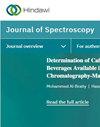LIBS Monitoring and Analysis of Laser-Based Layered Controlled Paint Removal from Aircraft Skin
IF 2.1
4区 化学
Q4 BIOCHEMICAL RESEARCH METHODS
引用次数: 3
Abstract
Reliability and controllability of selective removal of multiple paint layers from the surface of aircraft skin depend on effective online monitoring technology. An analysis was performed on the multi-pulse laser-induced breakdown spectroscopy (LIBS) on the surface of the aluminum alloy substrate, primer, and topcoat. Based on that, an exploration was conducted on the changes of the characteristic peaks corresponding to the characteristic elements that are contained in the topcoat, primer, and substrate with different layers of a laser action, in combination with analysis of microscopic morphology, composition, and depth of laser multi-pulse pits. The results show that the appearance and increase of the characteristic peak intensity of the Ca I at the wavelength of 422.7 nm can be regarded as the basis for the complete removal of the topcoat; the decrease or disappearance of the characteristic peak intensity can be regarded as the basis for the complete removal of the primer. Al I spectrum at the wavelength of 394.5 nm and 396.2 nm can be adopted to characterize the degree of damage to the aluminum alloy substrate. The feasibility and accuracy of the LIBS technology for the laser selective paint removal process and effect monitoring of aircraft skin were verified. Demonstrating that under the premise of not damaging the substrate, laser-based layered controlled paint removal (LLCPR) from aircraft skin can be achieved by monitoring the spectrum and composition change law of specified wavelength position corresponding tothe characteristic elements that are contained in the specific paint layer.基于激光分层控制的飞机蒙皮脱漆LIBS监测与分析
飞机蒙皮表面多层涂料选择性去除的可靠性和可控性取决于有效的在线监测技术。对铝合金基材、底漆和面漆表面进行了多脉冲激光诱导击穿光谱(LIBS)分析。在此基础上,结合对激光多脉冲坑的微观形貌、组成和深度的分析,探讨了激光作用不同层位的面漆、底漆和基材中所含特征元素对应的特征峰的变化。结果表明:Ca I在422.7 nm波长处的出现和特征峰强度的增加可以作为完全去除面漆的基础;特征峰强度的减小或消失可视为底漆完全去除的依据。可以采用394.5 nm和396.2 nm波长的Al I光谱来表征铝合金基体的损伤程度。验证了LIBS技术用于飞机蒙皮激光选择性除漆工艺及效果监测的可行性和准确性。证明了在不损坏基材的前提下,通过监测特定涂料层中所含特征元素对应的特定波长位置的光谱和成分变化规律,可以实现基于激光的飞机蒙皮分层控制除漆(LLCPR)。
本文章由计算机程序翻译,如有差异,请以英文原文为准。
求助全文
约1分钟内获得全文
求助全文
来源期刊

Journal of Spectroscopy
BIOCHEMICAL RESEARCH METHODS-SPECTROSCOPY
CiteScore
3.00
自引率
0.00%
发文量
37
审稿时长
15 weeks
期刊介绍:
Journal of Spectroscopy (formerly titled Spectroscopy: An International Journal) is a peer-reviewed, open access journal that publishes original research articles as well as review articles in all areas of spectroscopy.
 求助内容:
求助内容: 应助结果提醒方式:
应助结果提醒方式:


